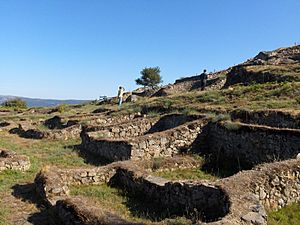Coelerni facts for kids
The Coelerni were an ancient Celtic tribe. They lived in a region called Gallaecia in Hispania, which is now part of Spain. Specifically, they lived in the southern part of the Ourense province in Galicia. They were part of the larger Gallaeci people.
Contents
Who Were the Coelerni?
The Coelerni were a group of people living in ancient times. They were part of the Celtic tribes in the Iberian Peninsula. This area later became a Roman Province called Hispania Tarraconensis.
Where Did We Learn About Them?
We know about the Coelerni from a few old writings. Writers like Pliny and Ptolemy mentioned them. They also appear on an important stone inscription. This inscription is found on a column in Chaves, Portugal. It's on a Roman bridge in Chaves.
The inscription lists ten different groups, or civitates. These groups honored the Roman Emperor Vespasian. The Coelerni were one of these groups. Pliny, who worked in the Iberian Peninsula, also wrote about them. He mentioned them as one of the 24 groups in the Braga area.
Their Main City
The most important city for the Coelerni was called Coeliobriga. Today, this place is known as Castromao. It is located in Celanova, which is in Ourense, Galicia, Spain.
This ancient settlement, known as a Castro, was lived in for a long time. People lived there from about 600 BC until the early 300s AD.
Friendship with Rome
The Coelerni made a special agreement with the Romans in 132 AD. This was a Treaty of Friendship. A special bronze tablet, called a Tessera Hospitalis, was found. It talks about this agreement.
This tablet showed a pact of hospitality. It meant the Coelerni tribe peacefully joined the Roman area called Hispania Citerior. In return, the Romans promised to protect them. This agreement was made with a Roman military leader. His name was Gneo Antonius Aquilus Novaugustanus. He was a commander of the Legion VII Gemina. This happened during the time of Emperor Hadrian.
The tablet explained that the Coelerni and the Roman commander agreed to be friends. This friendship included their children and future generations.
See also
 In Spanish: Coelernos para niños
In Spanish: Coelernos para niños


